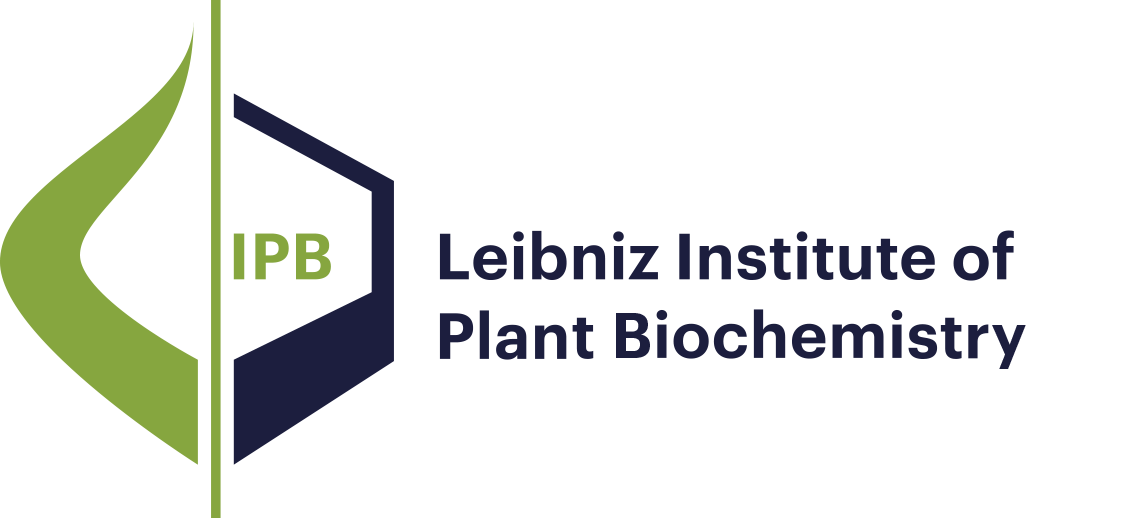- Results as:
- Print view
- Endnote (RIS)
- BibTeX
- Table: CSV | HTML
Books and chapters
Books and chapters
Books and chapters
Books and chapters
Books and chapters
Research Mission and Profile
Molecular Signal Processing
Bioorganic Chemistry
Biochemistry of Plant Interactions
Cell and Metabolic Biology
Independent Junior Research Groups
Program Center MetaCom
Publications
Good Scientific Practice
Research Funding
Networks and Collaborative Projects
Symposia and Colloquia
Alumni Research Groups
Books and chapters
Polyunsaturated fatty acids (PUFAs) are a source of numerous oxidation products, the oxylipins. In leaves, α-linolenic acid (α-LeA) is the preferential substrate for lipid peroxidation reactions. This reaction may be catalyzed either by a 9-lipoxygenase (9-LOX) or by a 13-LOX and oxygen is inserted regioselectively as well as stereospecifically leading to formation of 13S- or 9S-hydroperoxy octadecatrienoic acid (13-/9-HPOT; Brash, 1999). At least, seven different enzyme families or reaction branches within the LOX pathway can use these HPOTs or other hydroperoxy PUFAs leading to (i) keto-PUFAs (LOX); (ii) epoxy hydroxy-PUFAs (epoxy alcohol synthase, EAS); (iii) octadecanoids and jasmonates (allene oxide synthase, AOS); (iv) leaf aldehydes and leaf alcohols (hydroperoxide lyase, HPL); (v) hydroxy PUFAs (reductase); (vi) divinyl ether PUFAs (divinyl ether synthase, DES); and (vii) epoxy- or dihydrodiol-PUFAs (peroxygenase, PDX; Fig. 1; Feussner and Wasternack, 2002).
Books and chapters
IntroductionA Summary of Bioactive Glycosylated Secondary MetabolitesAgents that Interact with DNAEnediynesBleomycinsDiazobenzofluorenesAnthracyclinesPluramycinsAureolic AcidsAgents that Interact with RNAOrthosomycinsMacrolidesAminoglycosidesAmicetinsAgents that Interact with Cell Walls and Cell MembranesNon‐Ribosomal PeptidesPolyenesSaccharomicinsAgents that Interact with ProteinsIndolocarbazolesCoumarinsBenzoisochromanequinonesAvermectinsAngucyclinesCardiac GlycosidesLignansAnthraquinone GlycosidesGinsenosidesGlycoalkaloidsGlucosinolatesAgents that Interact with Other (or Undefined) TargetsPlant PhenolicsMono‐ and Triterpenoid GlycosidesPlant Polymeric Natural GlycosidesConclusionsReferences
Books and chapters
Mycorrhizas are by far the most frequent occurring beneficial symbiotic interactions between plants and fungi. Species in >80% of extant plant families are capable of establishing an arbuscular mycorrhiza (AM). In relation to the development of the symbiosis the first molecular modifications are those associated with plant defense responses, which seem to be locally suppressed to levels compatible with symbiotic interaction (Gianinazzi-Pearson, 1996). AM symbiosis can, however, reduce root disease caused by several soil-borne pathogens. The mechanisms underlying this protective effect are still not well understood. In plants, products of the enzyme lipoxygenase (LOX) and the corresponding downstream enzymes, collectively named LOX pathway (Fig. 1B), are involved in wound healing, pest resistance, and signaling, or they have antimicrobial and antifungal activity (Feussner and Wasternack, 2002). The central reaction in this pathway is catalyzed by LOXs leading to formation of either 9- or 13-hydroperoxy octadeca(di/trien)oic acids (9/13-HPO(D/T); Brash, 1999). Thus LOXs may be divided into 9- and 13-LOXs (Fig. 1A). Seven different reaction branches within this pathway can use these hydroperoxy polyenoic fatty acids (PUFAs) leading to (i) keto PUFAs by a LOX; (ii) epoxy hydroxy-fatty acids by an epoxy alcohol synthase (EAS); (iii) octadecanoids and jasmonates via allene oxide synthase (AOS); (iv) leaf aldehydes and leaf alcohols via fatty acid hydroperoxide lyase (HPL); (v) hydroxy PUFAs (reductase); (vi) divinyl ether PUFAs via divinyl ether synthase (DES); and (vii) epoxy- or dihydrodiolPUFAs via peroxygenase (PDX; Feussner and Wasternack, 2002). AOS, HPL and DES belong to one subfamily of P450-containing enzymes, the CYP74 family (Feussner and Wasternack, 2002). Here, the involvement of this CYP74 enzyme family in mycorrhizal roots of M. truncatula during early stages of AM symbiosis formation was analyzed.
Books and chapters
Jasmonic acid (JA) and its precursor 12-oxo phytodienoic acid (OPDA) are lipid-derived signals in plant stress responses and development (Wasternack and Hause, 2002). Within the wound-response pathway of tomato, a local response of expression of defense genes such as the proteinase inhibitor 2 gene (PIN2) is preceded by a rise in JA (Herde et al., 1996; Howe et al., 1996) and ethylene (O’Donnell et al., 1996). Mutants affected in JA biosynthesis such as defl (Howe et al., 1996) or spr-2 (Li et al., 2002) clearly indicated that JA biosynthesis is an ultimate part of wound signaling. It is less understood, however, how the rise in JA is regulated.
Books and chapters
The HrpZ gene product, harpin, is an export substrate of the type III secretion system of phytopathogenic Pseudomonas syringae. The role of this protein in pathogenesis is largely unknown. We previously determined that HrpZ binds to lipids and can form cation pores in synthetic lipid bilayers. Such pore-forming activity may allow nutrient release during bacterial colonisation of host plants. In addition. HrpZ is known to trigger plant defence responses in a variety of plants, such as tobacco. We have previously also characterised a binding site in tobacco plasma membranes that likely mediates HrpZ-induced defence responses. In order to reconcile these findings, we pose the question as to whether the activation of plant defence responses by HrpZ is mediated through a “classical” receptor perception mode or if plant membrane perturbation through the inherent pore-forming activity of HrpZ may induce defence responses. As defence in parsley cells can be induced both in a receptor-mediated manner or through ionophores these cells served as an ideal system for our analysis. We first performed ligand binding studies to characterise the presence of a binding site/receptor. We further digested HrpZ with endopeptidases and used subfragments of HrpZ to assess the elicitor-active domain of HrpZ. A C-terminal region of HrpZ appears to be sufficient to elicit plant defence responses. A novel assay involving dye-loaded liposomes was developed to validate previous electrophysiological findings on HrpZ-mediated cation pore formation. More importantly, this assay was used to establish if the elicitor-active C-terminal fragment of HrpZ could form pores. Our findings suggest that the structural requirements for ion pore formation and activation of plant defence responses by HrpZ are different. Thus, ion pore formation alone may not explain the activation of plant defence by HrpZ.

